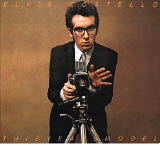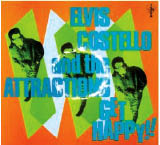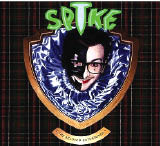Miracle Man
by Donny Kutzbach

You’re a rock-and-roll icon who is also respected in country, jazz, opera and classical music circles. Some of the greatest living songwriters call you to co-author tracks. You’re a totem to music hipsters but populist enough to guest on TV sitcoms. You can only be one person: Elvis Costello.
“Born in the middle of a second baby boom,” as he sang on “Opportunity” from 1980’s Get Happy!!, Declan Patrick MacManus came into the world on August 24, 1954 in London, England. Music was always swirling around young Declan. Not only did he come of age during rock-and-roll’s beat explosion in England, but father Russ was a trumpeter and vocalist with the Joe Loss Orchestra. Influenced by music of all kinds—Strauss, Billie Holiday, Bob Dylan, the Kinks—by 1970 he was gigging and writing songs.
Flash forward to 1977, when his demo tape gets him signed to fledgling independent Stiff Records and—at the urging of his manager/label chief Jake Rivera—the former Declan Macmanus changes his name to Elvis Costello. He’s barely had a second to look back since.
Beyond being a songwriter par excellence and unrivaled performing and recording artist, Costello’s magic lies additionally in the fact that he has been impossible to rope into any specific genre. He will forever be associated with the new wave daze of his early years. Like a bespectacled punk laureate, the legendary series of records he made with the Attractions remain as fresh today as they were more than 25 years ago and are totems for multiple generations.
Still, when he would get the yen to record an album in Nashville with producer Billy Sherill, and he’d do it (1982’s Almost Blue). He’s made jazz and classical recordings and along the way worked with everyone under the sun: writing with giants like Paul McCartney and Burt Bacharach, recording with Chet Baker, producing the Pogues and backing Roy Orbison. (One of his most recent collaborators is his jazz singer/pianist wife Diana Krall; thus far the pair have written a record and produced twin sons.)
Another facet of Costello’s strength is that to this day he remains an eager, tireless music aficionado and ardent fan.
Back in 2002, I went to New York City for a couple of tapings for the short-lived series Musicians. In one day, the show was putting two episodes in the can: Randy Newman and Elvis Costello. Costello sat through Newman’s entire taping along with the rest of the audience, admiring each note and hanging on each bit of wit and wisdom that Newman imparted.
Costello’s craft continues to grow. Last year, he issued The River in Reverse (Verve) with New Orleans funky soul maestro Allen Toussaint, an album that triptychs the spirit of the Crescent City from the roots of jazz and blues through the travails post-Katrina. At the end of the month, Costello—who doesn’t usually open for anyone—will perform solo before Bob Dylan and his band on a string of dates, including an October 9 stop in Rochester.
Elvis Costello performs with Steve Nieve this Friday, September 7, headlining Albright-Knox’s Rockin’ at the Knox, with Feist, Paolo Nutini and Brett Dennen.
Elvis’ Army
A selection of attractive and imposing classics from the Costello catalog.
My Aim Is True
(1977, Hip-O Select/Universal)
From behind horn rims with his legs splayed and gripping his Fender Jazzmaster like a machine gun, the cover says it all. Here’s the opening salvo from the great new hope new wave—as they were calling it—in the form of a literate and bile-blasting singer/songwriter versed in the rock-and-roll past but looking well ahead of what was in front of him. Among the gems across the Nick Lowe-produced My Aim Is True are the brilliant kiss-off “Miracle Man,” the sharp-reggae-meets-Bernard-Hermann-imbibed groove of “Watching the Detectives” and the king of toxic (but downbeat) breakup songs, “Alison.”

This Year’s Model
(1978, Hip-O Select/Universal)
In his first record with the Attractions, written and recorded just after he quit his day job, Costello has perhaps the most perfect rock record he’s ever made and arguably one of the best of the era. This Year’s Model packs an unequalled batch of tracks, like the driving rhythm and vigor of “Pump It Up,” the discordant cool of “The Beat,” the pathos and paranoia of “(I Don’t Want to Go to) Chelsea” and the anthemic, anti-airwaves rant “Radio, Radio.”
Armed Forces
(1979, Hip-O Select/Universal)
Don’t be fooled by the blissful pop badckdrops, there’s a lot of weird and dangerous stuff going on: fascists both real and figurative, hypnotic newscasters and more. Finish it off with the cover of Nick Lowe’s “(What’s So Funny ’Bout) Peace, Love and Understanding” and this is as good a record as you can get.

Get Happy!!
(1980, Hip-O Select/Universal)
Elvis and the Attractions lean on Motown and Stax sounds of the 1960s in what at the time seemed like a decisive break from his “angry young man of new wave” status. Twenty-seven years on, it simply sounds like one of the crispest, coolest records that Elvis and the band ever made. Packed with compact, single-ready tracks bursting with soulful energy and a sunny rock punch.
Imperial Bedroom
(1982, Hip-O Select/Universal)
Following his countrypolitan journey to Nashville trip on Almost Blue, Costello and the Attractions decamped to George Martin’s AIR Studios in London to work with noted Beatles engineer Geoff Emerick. Often called his “baroque pop” record, Imperial Bedroom is Costello backed by heavy arrangements and lovelorn lyrics (“Kid About It”) and torchy delivery (“Almost Blue.”) It is in line not only with the Fabs’ pastiched masterwork Sgt. Pepper but also haunted by Jacques Brel and the dark yet airy jazz of Chet Baker. Punk’s poet laureate was proving anything but punk at this point.

Spike
(1989, Rhino)
Bearing a pair of cowrites with Paul McCartney—the bittersweet “Veronica” and the abstracted raveup rocker “Pads, Paws and Claws”—Mr. Macmanus left the Attractions out and called in some heavy hitters, with guests including McCartney, T-Bone Burnett, Roger McGuinn, Chrissie Hynde, Dirty Dozen Brass, Mark Ribot and Allen Toussaint. It’s classic Costello with a smattering of all different styles and moods. The late 1980s production holds Spike back a bit years on, but song for song it remains one of his diversely plotted best.
When I Was Cruel
(2002, Virgin)
Upon release, the sticker on the cover jokingly touted, “His first loud album in years,” but there’s more to it than that. This was the return of the old band, too…sort of. The Attractions (sans Bruce Thomas) returned to become the Imposters and backed Costello for a record that many felt was a return to classic form, however exactly you classify that. It boasts songs like the wonderful triple-entendre melodic rocker “45,” the scathing and semi-autobiographical, John-Barry-feeling “When I Was Cruel No. 2” and the skewered pop tones of “Alibi.”
North
(2003, Universal Classics)
A breathtaking song cycle written and arranged by Costello and complete with full orchestra. It’s a remarkable throwback to Sinatra’s great, light night albums of longing and loss.
The Delivery Man
(2004, Lost Highway)
With the Imposters officially in tow and Emmylou Harris and Lucinda Williams guesting, this mélange of down-home country soul—bolstered by the gospel pine of “Country Darkness” and the deep, brooding blues of the title track—is magnificent at every turn.
And a lost, out-of-print classic:

Costello & Nieve
(1996, Warner Brothers)
Initially offered only as promos to promote 1996’s All This Useless Beauty, this collection of EPs captures Costello and his long-standing pianist Nieve playing as a duo in small venues across America. This set hints at the what Friday’s Rockin’ at the Knox is likely to sound like—elegantly stripped down and letting the songs speak for themselves—and that’s something to savor.
|
Issue Navigation> Issue Index > v6n36: Curtain Up! (9/6/07) > Miracle Man This Week's Issue • Artvoice Daily • Artvoice TV • Events Calendar • Classifieds |









 Current Issue
Current Issue